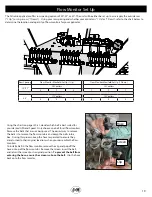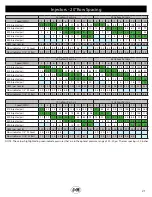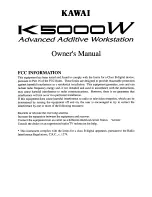
17
1. Hook tractor to NitroGro and adjust hitch so that frame on applicator is level or
tilting backward slightly.
2. Connect hydraulic lines. See “Connecting the Hydraulic Hoses” on page 14.
3. Unfold the unit. See “Folding & Unfolding” on page 14.
4. Lower the unit until the lift cylinders bottom out on the stroke control spacers. Add or remove stroke control spacers until the center toolbar
section reaches desired application depth. For best results, move forward while lowering the toolbar.
5. Adjust the wing gauge wheels so the coulters on the wings are the same depth and the toolbar is level when lowered.
6. Using the desired rate of application (GPA) and speed of application (MPH), reference the supplied sizing charts beginning on page
20 of this manual to determine which orifices or injectors will provide optimal application pressure. Install the orifices or injectors
in the check valve unit above each row unit that is mounted on the coulter shaft.
NOTE – The unit will be either be set up to skip a row (“1 Down”), or re-apply the outside row (“1 Up”).
•
If the unit is set up as “1 Down” (23 or 35 coulters), then the outside coulters on each end of the unit will be 1.5x the rate
of the other coulters.
•
If the unit is set up as “1 Up” (25 or 37 coutlers), then the outside coulters on each end of the unit will be 0.5x the rate of
the other coulters.
7. Put water in the tank and check for leaks.
IMPORTANT - Before proceeding to the next step, ensure that both the maintenance valve under the tank and the agitation
valve is open to allow the pump to prime. NEVER run the pump dry.
8. With the maintenance valve open, perform initial setup of the pump as outlined in the pump operator’s manual. After pump set up,
recheck the applicator for leaks.
9. In-field adjustment of hydraulic down-pressure: Adjust so that the coulters stay at desired depth with the least amount of hydraulic
pressure necessary.
IMPORTANT - DO NOT exceed 1,350 psi. Exceeding 1350 psi is not warrantable.
10. Adjust hydraulic flow on the raise and lower/wing kick/down-pressure circuit with the least amount of hydraulic pressure necessary
while maintaining a reasonable speed to raise and lower the toolbar. This will prevent excess heat in the hydraulic system as this circuit
provides continuous toolbar down-pressure.
11. Fold the wings up for transport. See “Folding & Unfolding” on page 14.
IMPORTANT - Be sure to fully raise the toolbar before folding the wings up! Failure to do so will result in damage to the unit.
12. TIRE PRESSURE:
The following is to be used as a
general guide
for tire inflation for cyclic use. Figures can vary depending on
specific brand of tire used.
It is important that tires are inspected before and after operation. The tire should stand up with no
side wall buckling or distress as the tire rolls.
Do not exceed the tire pressure indicated below:
Operation
Tires for Gauge Wheels
psi
ST215-75D14 Carlisle Sport Trail Tire
45
Tires for Single Wheel Applicators
psi
VF320/105R46 (Alliance) (172D)
71
VF380/90R46 (Alliance) (173D)
57
VF480/80R50 (Alliance) (179D)
31
Tires for Walking Tandem Dual Wheel Applicators
psi
VF320/105R46 (Alliance) (172D)
20
VF380/90R46 (Alliance) (173D)
17
VF480/80R50 (Alliance) (179D)
12
















































